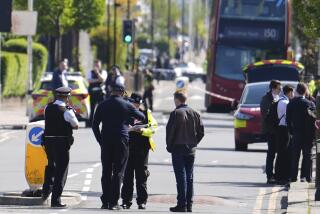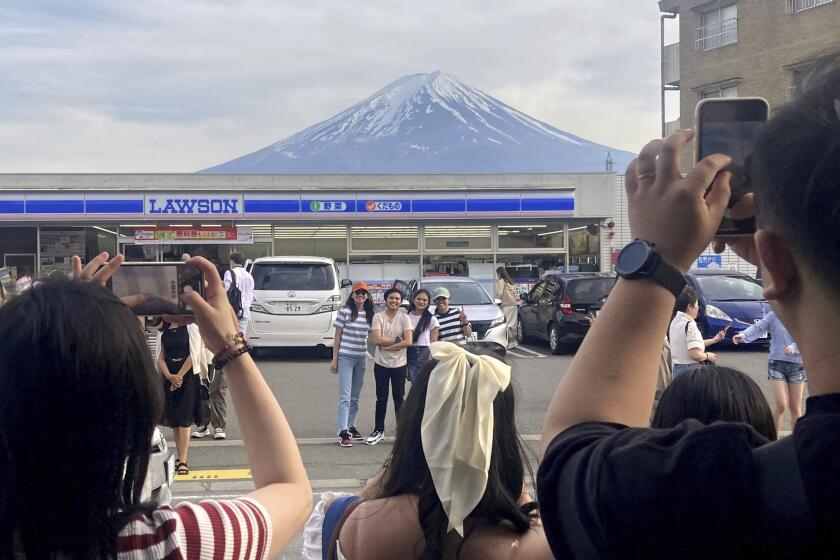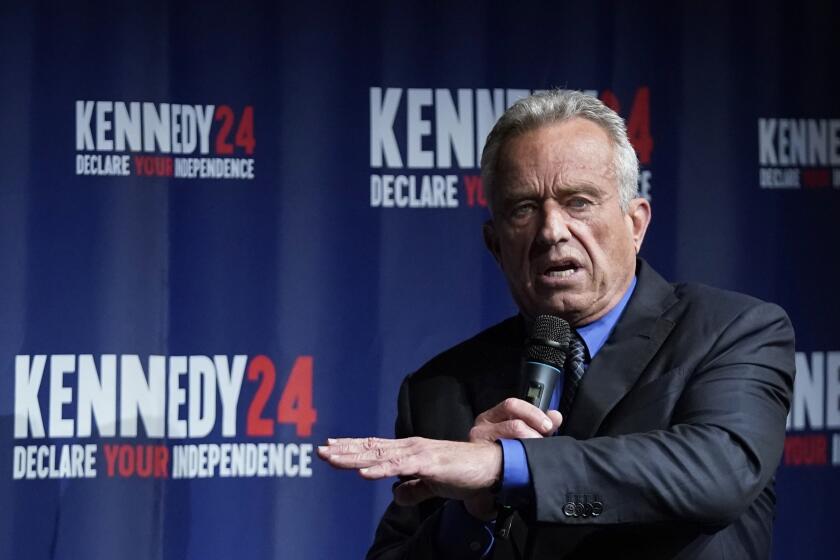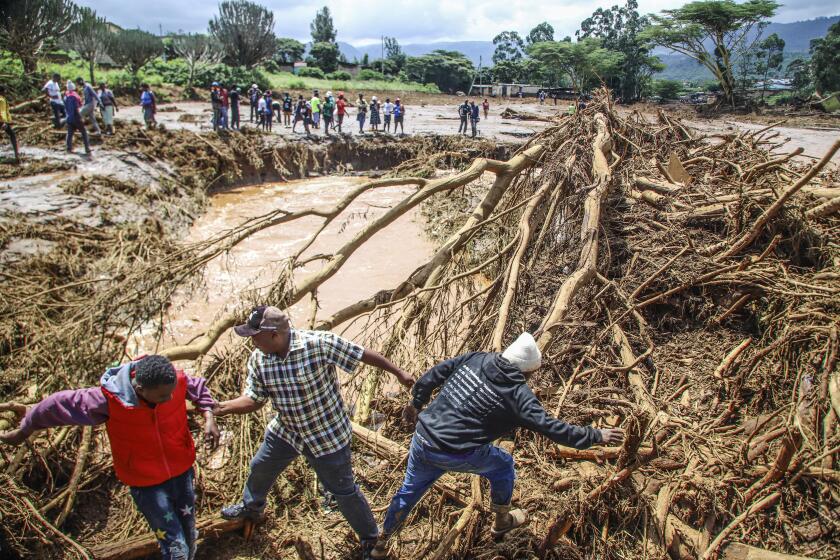Ritual and Pageantry Usher Reagan’s Coffin to Capitol
Borne by black hearse, presidential jet and horse-drawn caisson, the flag-shrouded coffin of Ronald Reagan was carried from California to the U.S. Capitol on Wednesday, viewed by political leaders and thousands of Americans who gathered for a last glimpse.
The 40th president’s final trek eastward was an all-day, tightly choreographed affair marked by solemn images of military pomp and a doleful widow -- a dramatic long goodbye for a former Hollywood leading man who came to dominate the American political stage.
On a sunny afternoon, fighter jets screeched over Washington in an airborne farewell while the ebony caisson ferried Reagan’s coffin toward the Capitol. Thousands of mourners were expected to view the former president lying in state before a funeral Friday. He died Saturday at 93.
As the procession moved through the city, crowds erupted in spontaneous applause for the historic symbols of national grief that many Americans were seeing for the first time: a dead president’s flag-draped coffin, a riderless horse trailing behind and processions of ramrod-straight military honor guards.
A throng of political leaders and foreign dignitaries led by Vice President Dick Cheney filed into the cavernous Rotunda of the Capitol, accompanying Reagan’s widow, Nancy, and her family as a military honor guard gently set his coffin onto a catafalque. The ceremonial pine plank bier was built in 1865 to support the remains of Abraham Lincoln.
Hailing Reagan as the “man who ended the evil empire” by facing down a tottering, bankrupt Soviet Union in the 1980s, Cheney recalled the former president as a “providential man who came along just when our nation and the world most needed him.”
President Bush, who was in Georgia for the Group of 8 economic summit, is to attend Reagan’s funeral Friday.
At poignant interludes during the long day’s journey, the finality of her husband’s last passage seemed to overwhelm Nancy Reagan. She appeared drawn and fragile as she trailed her husband’s casket into the hilltop courtyard of the Ronald Reagan Presidential Library near Simi Valley as it began the journey to Washington, and again, minutes later, on the tarmac at the Point Mugu Naval Air Station.
Nancy Reagan clutched the arm of Army Maj. Gen. Galen B. Jackman, her assigned military escort, as she haltingly climbed a steep jet ramp. But she seemed to gain strength when she turned at the jetway and waved to several hundred well-wishers. The crowd responded with a round of polite applause, prompting a wan smile from Mrs. Reagan before she disappeared into the jet’s cabin.
Hours later, as her husband’s coffin was hefted by an honor detail up the steep Capitol steps, she stood for long minutes, wavering slightly, until they completed the climb. Inside, she sat quietly as Cheney, House Speaker J. Dennis Hastert (R-Ill.) and Sen. Ted Stevens (R-Alaska) extolled her husband for ending the Cold War and ushering in an era of economic prosperity and national optimism.
“President Reagan dared to dream that America had a special mission,” Hastert said. “He always believed our best days were ahead of us, not behind us.”
When they were done, Nancy Reagan smoothed her black dress and walked to the coffin on Cheney’s arm. She brushed out a wrinkle on the flag shrouding the casket and bent over it, speaking in hushed tones.
Following her to the casket were national and foreign leaders who had shared the public stage during the Reagan era. Among them were former British Prime Minister Margaret Thatcher, a staunch Reagan ally.
Moments later came a stream of Reagan administration stalwarts: confidante and former Atty. Gen. Edwin Meese III; Secretary of State Colin L. Powell, who was Reagan’s national security advisor; and former Secretary of State George P. Shultz, who saluted a farewell.
They were the first of thousands of Americans who descended on Washington to say their own goodbyes.
Visitors staked out spots along the National Mall, sweating in 90-degree heat to somberly watch the procession make its way to the Capitol.
“Reagan changed the world. How could we not be here?” said Hughie Stambaugh, 38, a suburban Philadelphia church secretary who had driven to Washington with his 12-year-old step-grandson, Patrick Cassidy.
Beside them, Vicki Drummond, 54, a chaplain for the Alabama Republican Party who had driven to Washington with her son, Matt, from their home near Birmingham, recalled a blizzard of images from John F. Kennedy’s funeral in 1963, hoping the Reagan rites would leave their own lasting images.
“I just remember how graceful and strong Jackie Kennedy was, and Nancy Reagan’s been the same way,” she said. “It gives you comfort just watching her.”
They watched as Reagan’s casket was pulled from the hearse that had carried it from a local military air base and brought it to downtown Washington. It was strapped to the old artillery wagon pulled by a team of six horses. The artillery caisson and the riderless horse, which trailed behind, are traditional elements of the funeral procession of a national leader.
The black steed trotting behind the caisson was Sgt. York, a former racehorse named after the famous World War I Medal of Honor winner. Strapped backward into Sgt. York’s stirrups was a pair of Reagan’s favorite mahogany leather riding boots, turned backward to symbolize that he will never ride again.
Marie Feddo, cradling her 9-month-old daughter, Kaye, in her arms, wiped a single tear as she saw Nancy Reagan wave from the window of the limousine that followed behind.
“Ronald Reagan was an amazing president,” she said. “And I wanted the children to be part of something very special. They may not remember it, but I want them to be a part of history.”
Nearby, Jean Feigley, 88, stood dressed for a funeral, clad in a long black lace dress, her white hair pulled back in a bun. “He made me feel good about being an American,” she said of Reagan, as the drums sounded. “It’s nice to have somebody waving the flag.”
A line of policemen on motorcycles headed the procession, headlights winking blue and red. Drums played a slow staccato. A slow-stepping military band blared martial music that mixed with the clapping and cheers of the crowds.
When Nancy Reagan emerged briefly to view the crowds, a man yelled, “God bless you, Mrs. Reagan!” She smiled, waved briefly and returned to her limousine to a cascade of applause.
The caisson moved east along Constitution Avenue, saluted one by one by a vast twin row of military personnel along the thoroughfare. As the procession reached the Capitol grounds, a formation of fighter jets -- 21, to match the salute by military gunfire -- raked the sky.
As the roar of jet engines faded, Navy Lt. Christopher James, who works at the Navy Yard near the Washington waterfront, lifted his hand in salute. Then he raised a camera to capture the formation.
Near the Capitol, Carol Bauer, 56, who was a political appointee during the Reagan administration, clasped her hand to her heart, tears streaking her cheeks, when Sgt. York trotted past. The only other noise was a baby crying and people sniffing back tears.
She remembered Reagan as a “very approachable, very regular guy who knew where this country should go, who had the ability to lead by his words, his manner and his optimism.” Her husband, commentator and former Republican presidential primary candidate Gary Bauer, stood nearby on a 3-foot wall, angling for a better view.
By the time the procession passed, the crowd at Fourth and Constitution was eight to 10 people deep. Red-white-and-blue clothing was the fashion statement of the day. People lingered until a group of motorcycles riding in formation at the rear of the procession signaled that the coffin had reached the Capitol.
The Capitol grounds had been briefly evacuated Wednesday because of faulty radio contact with a small plane that entered restricted air space. The plane, carrying Kentucky Gov. Ernie Fletcher, was authorized to fly into the quadrant but was having problems with its radio transponder, which prevented traffic controllers from tracking the aircraft.
At the Capitol, a formation of Army, Navy, Marine and Air Force officers waited at attention on the building’s grand stairwell. The Reagan family, including daughter Patti Davis and son Ron Reagan, stood at the entrance, milling patiently while cannons were readied on the Capitol lawn for another of the day’s 21-gun salutes.
Finally, her escort slowly led Nancy Reagan down a long passageway. As she looked on, a military band played a doleful, stately “Battle Hymn of the Republic.” Blinking, she watched as the honor guard bent under her husband’s weight and carried his coffin past her.
Then, as the strains faded, Mrs. Reagan turned and headed for the Rotunda, where the hall full of notables waited in silence. The cadence of marching boots filled the room as Ronald Reagan made his entrance into the halls of government.
*
Times staff writers Ricardo Alonso-Zaldivar, Ashleigh Collins, Janet Hook and Richard Simon contributed to this report.
More to Read
Start your day right
Sign up for Essential California for news, features and recommendations from the L.A. Times and beyond in your inbox six days a week.
You may occasionally receive promotional content from the Los Angeles Times.






